AMD EPYC 3151 Benchmarks
For this exercise, we are using our legacy Linux-Bench scripts which help us see cross-platform “least common denominator” results we have been using for years as well as several results from our updated Linux-Bench2 scripts. At this point, our benchmarking sessions take days to run and we are generating well over a thousand data points. We are also running workloads for software companies that want to see how their software works on the latest hardware. As a result, this is a small sample of the data we are collecting and can share publicly. Our position is always that we are happy to provide some free data but we also have services to let companies run their own workloads in our lab, such as with our DemoEval service. What we do provide is an extremely controlled environment where we know every step is exactly the same and each run is done in a real-world data center, not a test bench.
We are going to show off a few results, and highlight a number of interesting data points in this article.
Python Linux 4.4.2 Kernel Compile Benchmark
This is one of the most requested benchmarks for STH over the past few years. The task was simple, we have a standard configuration file, the Linux 4.4.2 kernel from kernel.org, and make the standard auto-generated configuration utilizing every thread in the system. We are expressing results in terms of compiles per hour to make the results easier to read:
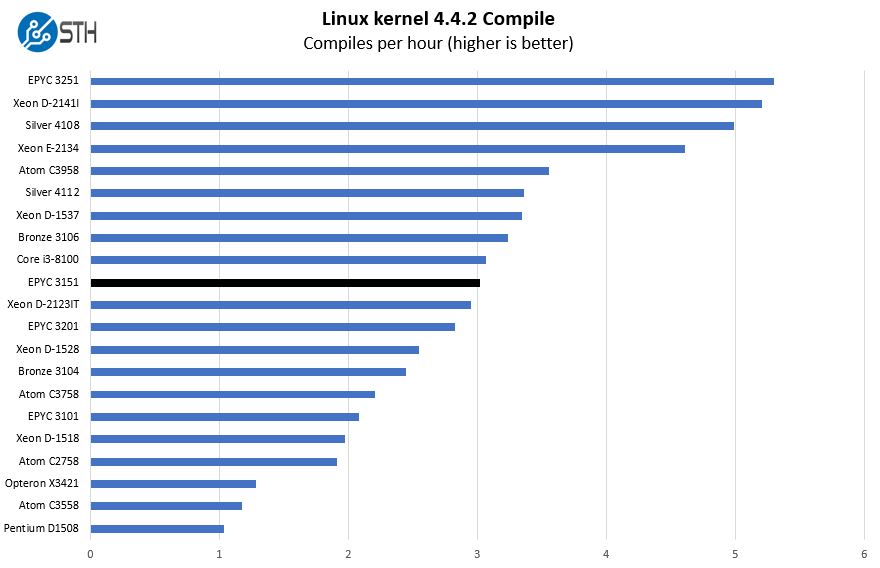
We have a certain order to our reviews. This is always our first chart. Every so often we get a result like this that has an absolute ton to unpack.
In a direct comparison to the Intel Xeon D-2123IT, a more expensive and 33% higher TDP (60W v. 45W) Intel Xeon D-2100 series part, the AMD EPYC 3151 notches a win. When we first saw the lineup at the AMD EPYC Embedded 3000 Series Launch our sense was that the Xeon D part would have performed better in this test. This is certainly a good case of why it is important to test a hypothesis. The delta was not large, but it was there.
Next, we are going to highlight the AMD EPYC 3151 actually performs better than the AMD EPYC 3201 8-core part. Here, higher TDP plus 2-way SMT means that in some cases the AMD EPYC 3151 will perform better. That will not always be the case throughout the rest of our benchmarks.
c-ray 1.1 Performance
We have been using c-ray for our performance testing for years now. It is a ray tracing benchmark that is extremely popular to show differences in processors under multi-threaded workloads. We are going to use our 4K results which work well at this end of the performance spectrum.
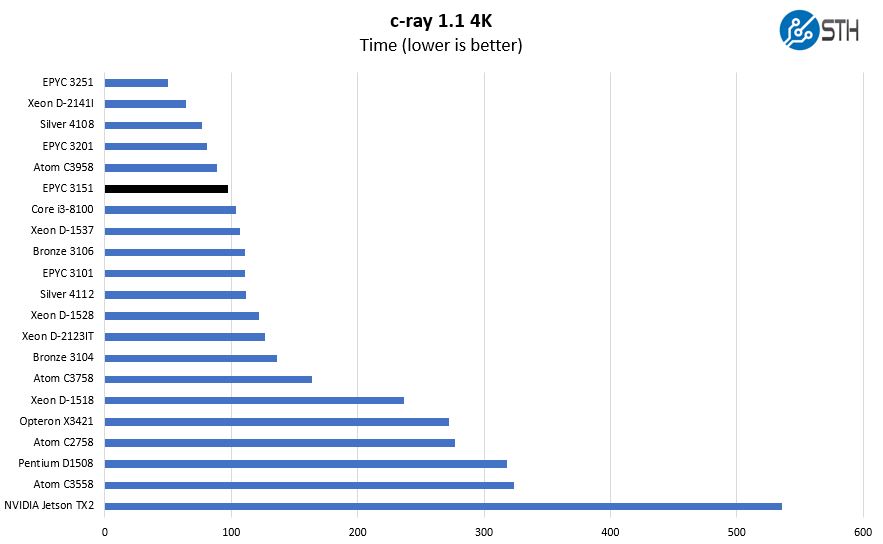
Here, the AMD EPYC 3201 with eight physical cores handily beats the AMD EPYC 3151. C-ray is a test that heavily favors the AMD “Zen” architecture, so we see the chip again place above four core Intel Xeon D-2123IT and even six-core Intel Xeon D-1528.
7-zip Compression Performance
7-zip is a widely used compression/ decompression program that works cross-platform. We started using the program during our early days with Windows testing. It is now part of Linux-Bench.
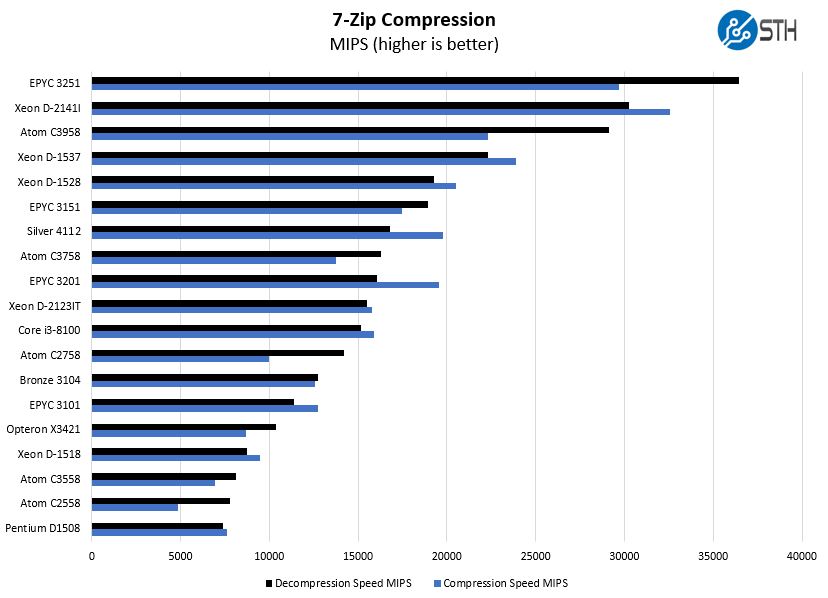
We traditionally sort this chart on decompression speeds. That is making a difference here. Like the AMD EPYC 3251 which has SMT at 8 cores and 16 threads, the AMD EPYC 3151 has higher compression than decompression numbers. There is a clear performance benefit for the AMD EPYC 3151 over the EPYC 3101 and Intel Xeon D-2123IT here. If we had sorted to compression speed, the AMD EPYC 3201 would have moved up several places.
NAMD Performance
NAMD is a molecular modeling benchmark developed by the Theoretical and Computational Biophysics Group in the Beckman Institute for Advanced Science and Technology at the University of Illinois at Urbana-Champaign. Note: we are using this without AVX2 and AVX-512 optimizations. We have those in a related benchmark, our GROMACS workload. More information on the benchmark can be found here. Here are the comparison results for the legacy data set:
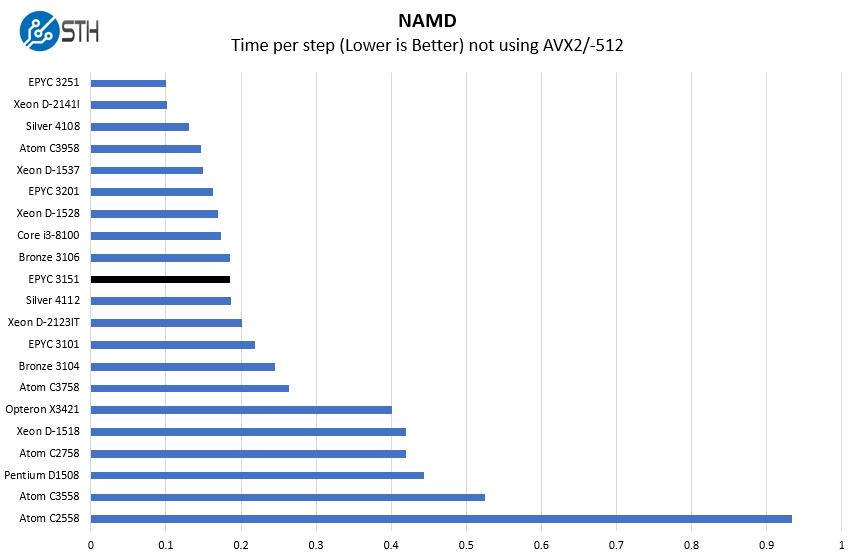
Here the AMD EPYC 3151 performs about on par with the 85W Intel Xeon Bronze 3106 (8 core/ 8 thread) and Intel Xeon Silver 4112 (4 core/ 8 thread.) The extra physical cores of the AMD EPYC 3201 shine in this test.
We wanted to note, we found that, despite Intel’s spec sheet, the Intel Xeon D-2100 series supports dual-port FMA AVX-512. We are going to show the impact in our GROMACS results later, but without newer extensions, AMD Zen performs very well.
Sysbench CPU test
Sysbench is another one of those widely used Linux benchmarks. We specifically are using the CPU test, not the OLTP test that we use for some storage testing.
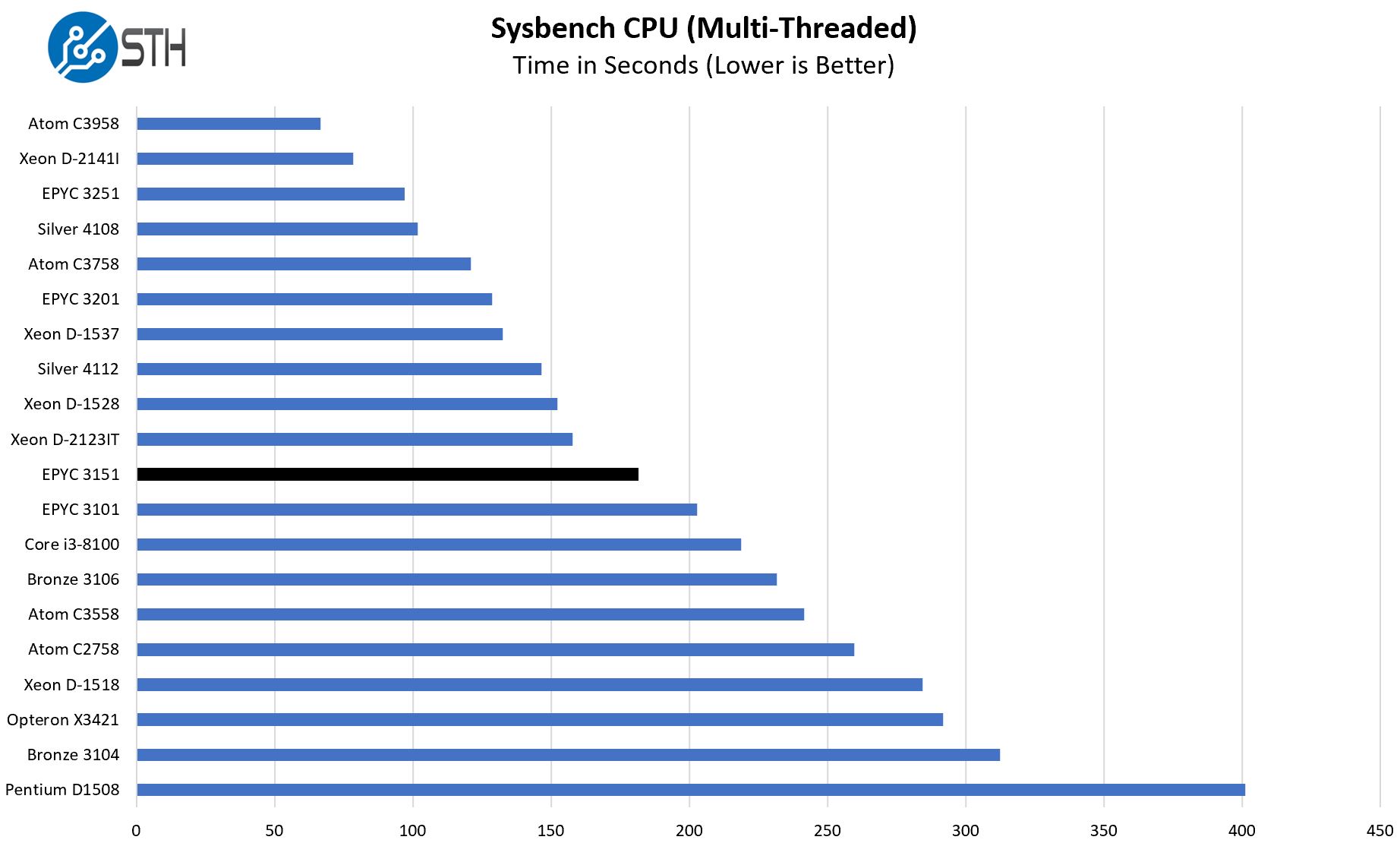
This result was interesting to us since AMD Zen generally does well here, but we consistently got performance better than the AMD EPYC 3101 but not quite up to the Intel Xeon D-2123IT.
OpenSSL Performance
OpenSSL is widely used to secure communications between servers. This is an important protocol in many server stacks. We first look at our sign tests:
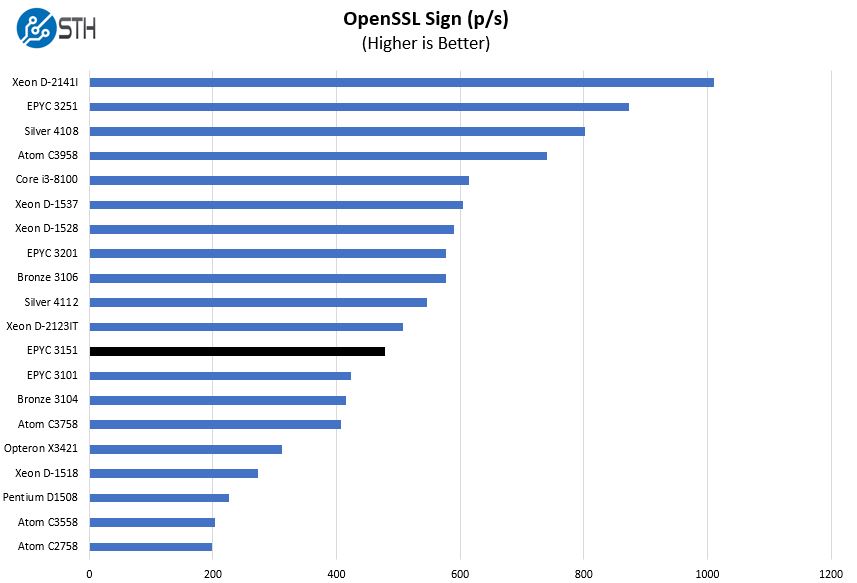
Here are the verify results:
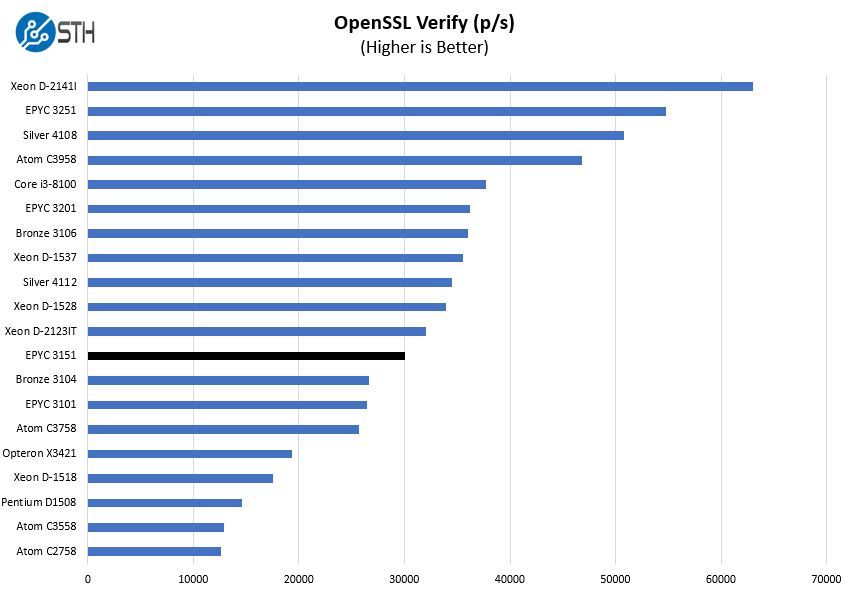
Here the AMD EPYC 3151 again shows a nice bump over the EPYC 3101, yet does not match the Intel Xeon D-2123IT. On the other hand, it has a fairly noticeable jump over the AMD Opteron X3421 part commonly found in the HPE ProLiant MicroServer Gen10.
UnixBench Dhrystone 2 and Whetstone Benchmarks
Some of the longest-running tests at STH are the venerable UnixBench 5.1.3 Dhrystone 2 and Whetstone results. They are certainly aging, however, we constantly get requests for them, and many angry notes when we leave them out. UnixBench is widely used so we are including it in this data set. Here are the Dhrystone 2 results:
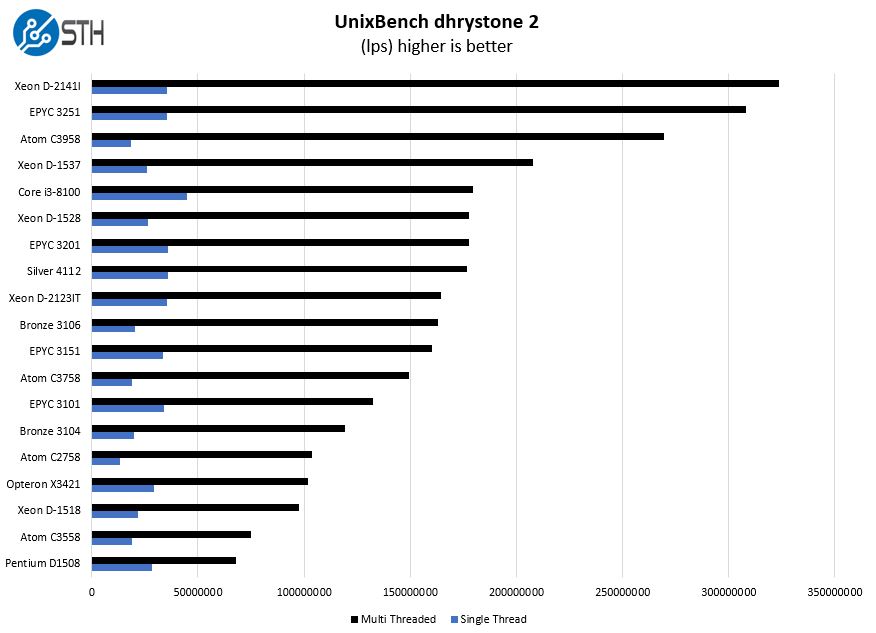
Here are the whetstone results:
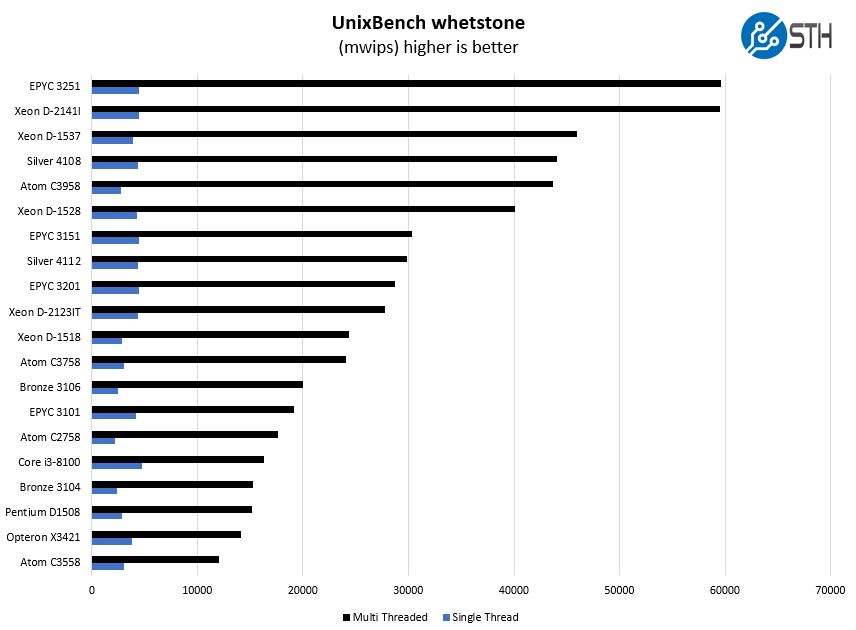
At 2.9GHz the Turbo clock speed is good for the embedded space. Only a few years ago a 2.9GHz quad-core would be one of the fastest embedded CPUs available. Here the overall multi-threaded results are closer to the quad core Intel Xeon Skylake parts which is a good showing given how much less expensive the AMD EPYC 3000 series parts are.
GROMACS STH Small AVX2/ AVX-512 Enabled
We have a small GROMACS molecule simulation we previewed in the first AMD EPYC 7601 Linux benchmarks piece. In Linux-Bench2 we are using a “small” test for single and dual socket capable machines. Our medium test is more appropriate for higher-end dual and quad socket machines. Our GROMACS test will use the AVX-512 and AVX2 extensions if available.
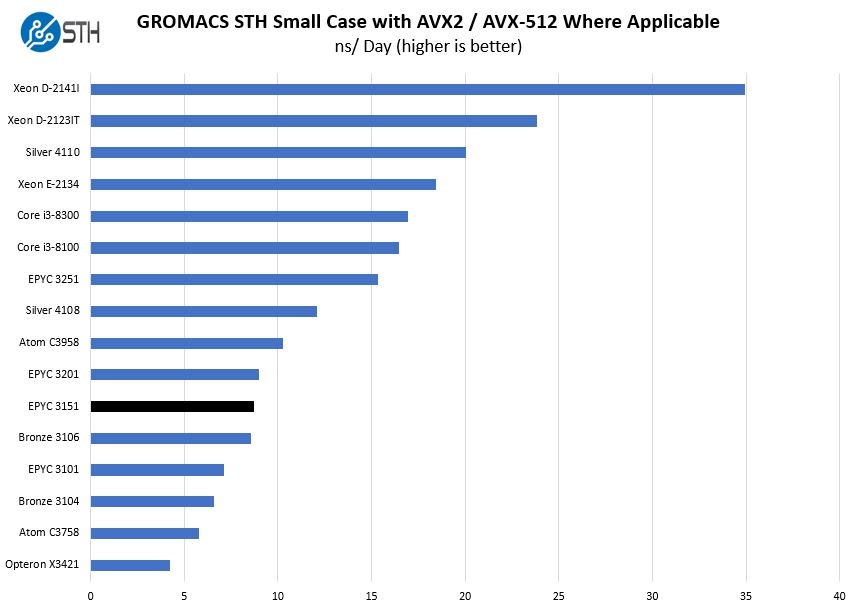
This is from our editor-in-chief, Patrick’s, AMD EPYC 3201 review, and it applies here as well:
This is simply a case where the Intel Xeon D-2100 series family pulls away. Officially the Skylake-D is noted as having single port FMA AVX-512 like the Intel Xeon Bronze, Xeon Silver, and Xeon Gold 5100 series. Clearly, Intel has dual port FMA AVX-512 on the Intel Xeon D-2100 series. I have asked Intel, and nobody will confirm that they are de-featuring the spec sheet, but I have received a “that is a very wise question” when asking it to someone at Intel who should know. (Source: Patrick Kennedy – STH)
Here the extra TDP headroom is almost enough for the AMD EPYC 3151 to match the EPYC 3201 8-core part.
Chess Benchmarking
Chess is an interesting use case since it has almost unlimited complexity. Over the years, we have received a number of requests to bring back chess benchmarking. We have been profiling systems and are ready to start sharing results:
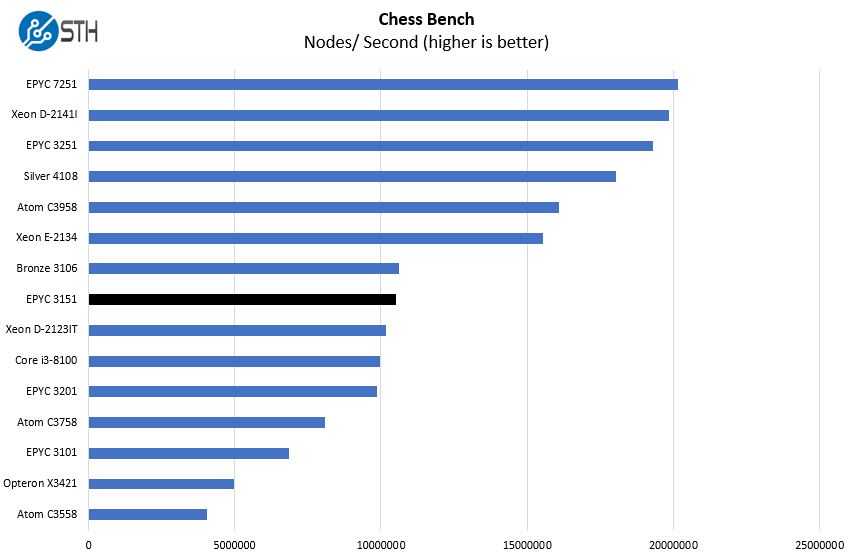
If you want more compute, the AMD EPYC 3251 shows almost a 2x performance gain in this case and leads the AMD EPYC 3151 throughout. For those making embedded appliances that want a range of SKUs from lower power and cost to higher power and cost, AMD has a nice range in its SKU stack well beyond what the Intel Xeon D-1500 series launched with in this segment years ago.
Next, we are going to talk AMD EPYC 3151 market positioning before moving on to our final words.




Why this scores better than EPYC 3251 in single thread whetstone?
I’m looking to build a very low power home server with plenty of cores to setup vms and ability to increase RAM as it fits my budget..
So far I’m torn between the Atom C3958 (that seems to trounce the Epyc in all benchmarks at 25W tdp too) and the Epyc 3201..
Any thoughts.. I’d run VMs to (1. router – pfsense, 2. NAS – FreeNAS, 3. Transcode h.265 to stream to my TV via some thin client/rpi there, 4. possibly host 2-3 windows desktops VDI to stream to thin clients)
how many passmarks can it pull that is more relevant for me because i know what my old i7 can pull in passmarks